There are countless audience segments to target for Google Ads campaigns, but what if none of them fit your goals?
Affinity, In-Market, and Similar audiences are all defined by Google. Even if you go for Remarketing audiences, where data on your website visitors is used to create a list of users, your input into audience creation isn’t limited, but the outcome is.
In this article, I’ll explore the power of custom segments targeting. From the basics to defining your audience and testing different combinations, to elevate your targeting results to new heights.
Get ready to revolutionize your targeting game!
Table of Contents
What Are Custom Segments (Previously Custom Audiences) in Google Ads?
Custom Segments is a targeting feature in Google Ads that allows advertisers to create highly specific audience segments by defining criteria such as keywords, URLs, and apps.
Custom segments are probably the best segment in Google Ads because it allows you to define the criteria for targeting users. Although Google provides data for the process, advertisers have significant control over the criteria used for targeting.
The targeting for custom segments is set up based on keywords, URLs, and apps.
Your task is to select these three parameters, and Google will match them with users. So, when creating a new custom segment, think of the keywords your customers type in search engines, the websites they visit, and the applications they use. You don’t need the three of them, you can have only one or a combination.
Once you do that, the process is pretty much automatic. As long as the targeting method aligns with Google’s ad policy, Google will take care of it for you.
How Does Custom Segment Targeting Work?
Google uses the info you give to find the people that correspond to that selection. This process allows Google Ads to create a highly specific audience segment that is in line with your advertising goals, particularly if you are using smart bidding strategies.
More specifically, the custom segment will correspond to one of these three stages of the customer journey (you can create customer segments that correspond to each stage):
- Reach: top of funnel audience, creating brand awareness;
- Consideration: mid-funnel audience, or users whose online behavior (search history) indicates purchase intent;
- Performance: low funnel audience, or users who show high purchase intent and are ready to take action.
Custom segments are ideal for targeting mid- to low-funnel audiences because you can get really specific when defining keywords, URLs, and apps for the segment.
This level of granularity is not available in any other audience segment in Google Ads.
So, if you’re looking to really hone in on your audience and drive conversions, custom segments are the way to go.
For instance, take a custom segment consisting of users who:
- search for long tail keywords like “which running shoes are good for running marathons,”
- use apps like “Strava,” “IRONMAN Tracker,” and similar; and
- visit sites like “Triathlete,” “Endurance Planet,” “Sportsnutrition,” etc.
Now, maybe the triathlon industry isn’t relevant to your business, but this example illustrates the power of custom segments for reaching your ideal customer.
Let’s take a peek at the dashboard.
How Do You Create Custom Segments in Google Ads?
To find Custom Segments in Google Ads, go to Tools and Settings and open Audience Manager in the Shared library column. There is a tab labeled “Custom Segments” in the Segments menu.
Here, you can check out the custom segments that are already created.
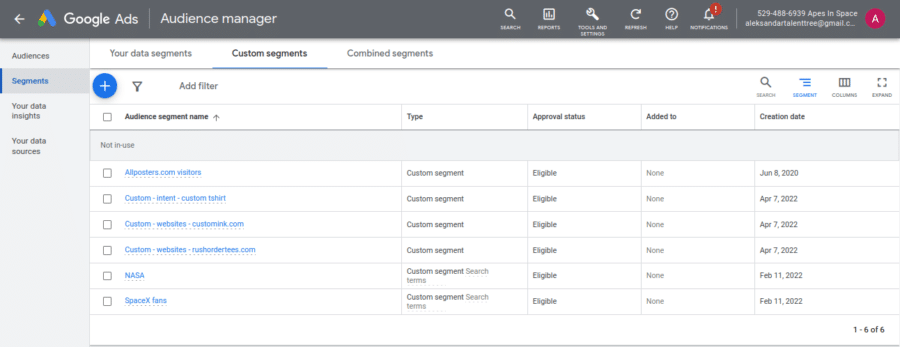
To start creating a new custom segment, click the blue button with a plus sign in the upper left corner. This will open a dialog box where you can define the parameters of your custom segment.
Let’s take a look at the options you can choose.
Which Custom Segments Are Available in Google Ads?
There are five options you can choose from:
- People with any of these interests or purchase intentions
This is a keyword-based targeting option. You can enter keywords that describe your customer to help Google gauge users’ purchase intent.
For example, if you sell fitness equipment, you can enter keywords like “gym equipment” or “fitness gear” to target people who are interested in buying fitness equipment.
- People who searched for any of these terms on Google
This is also keyword-based targeting, but limited to searches within Google properties.
If you sell running shoes, you can enter keywords like “running shoes” or “best running shoes” to target people who have searched for those terms on Google.
- People who browse types of websites
This one allows you to target users by entering the URLs they visit. If a user visits the website, they won’t see your ad while browsing the website but will be added as a segment member and shown an ad as part of a campaign.
If you sell pet food, you can target users who visit websites related to pet care, such as pet supply stores or pet health websites.
- People who use types of apps
It targets users who download and use specific apps. Again, the ad won’t be shown on the app, but the user will be added as a segment member to your campaign.
If you sell meal prep services, you can target users who use fitness or nutrition apps, such as MyFitnessPal or Fitbit.
- People who visited certain places
This one targets users based on the locations they visit. This is not limited to physical locations, but can also be locations like a specific school at a specific location.
If you own a local coffee shop, you can target users who have visited nearby locations such as a bookstore or a gym.
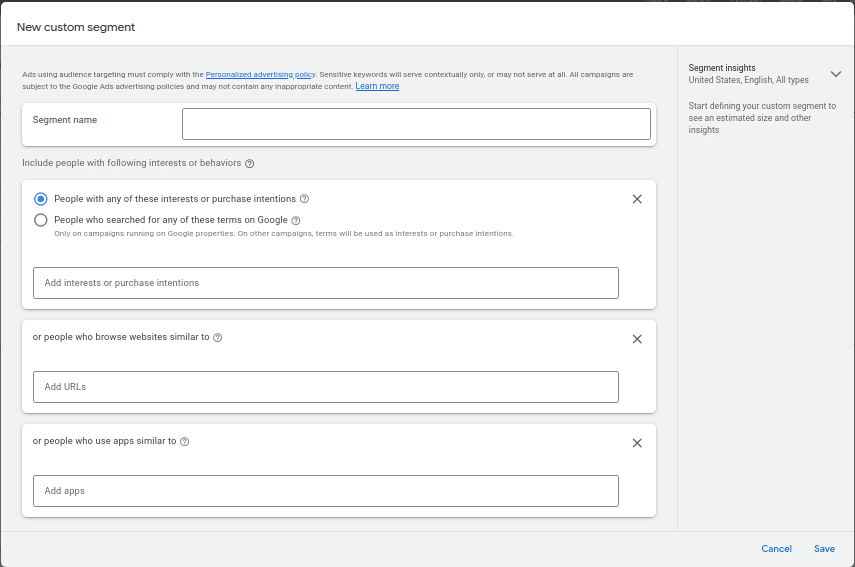
You have to choose one of the first two options. The second (searches for campaigns within Google Properties) is more attractive to marketers because it’s a form of search retargeting. It’s meant for Search, YouTube, and Discovery campaigns and enables you to define segment members by keywords that are valuable for your brand.
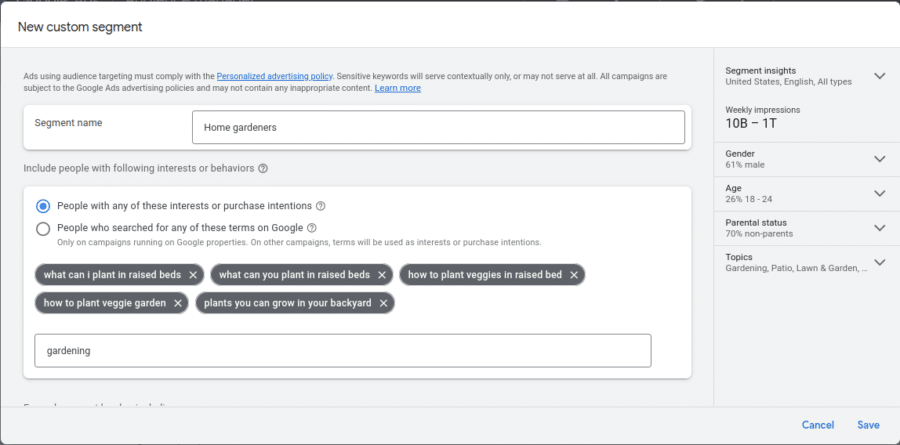
The first option (interests or purchase intentions) is more like behavioral targeting based on search history and is for campaigns on the Display network.
People who browse websites and People who use apps give more targeting options to marketers who want to expand the segment. They are introduced to the custom segment following an “or” logic (not “and” logic), so when you add them, the audience grows.
You can use any combination of these four options to define your custom segment.
Interpreting Segment Insights
On the right side, you get estimates about the resulting custom segment. Here, you can further define the segment by country, language, and campaign type.
As soon as you do that, you get three important audience insights:
- Weekly impressions
It’s an estimate expressed as a range (for example, 10K to 1M). The broader the keyword, the bigger the audience. Bear in mind that these are not unique visits but impressions.
- Demographics
Basic demographic data on gender, age, and parental status of the users in the created custom segment (expressed as a percentage). This is just a notification; if you want to exclude a certain demographic, you’ll have to do it via Google Ads Demographic or Detailed Demographic once the audience is targeted in a campaign.
- Topics
The topics covered by the keywords, URLs, and apps. You can use this list to check whether you’re missing some important subset of customers.
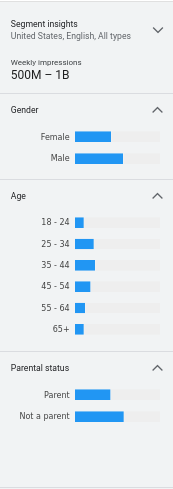
Note: custom segments are not a remarketing campaign. The users don’t have to visit your website to be included in a custom segment; they might just visit your competitors’ websites. If you define the custom segment using the right criteria, you can target them.
Which Campaigns Can Use Custom Segments?
Custom segments are available only for Display, Discovery (Gmail), and Video (YouTube) campaigns. They are not available in Search or Shopping. The Search equivalent of custom segments is where you target past website visitors based on keywords. However, as the name implies, that is a remarketing campaign, while custom segments are not.
Tips on Creating Custom Audience Segments
Finding the ideal customer persona is like trying to find a needle in a haystack, except the needle keeps changing its shape and color.
But don’t worry, with some detective work and a bit of trial and error, you’ll find your ideal customer persona in no time!
How to Select Keywords for Custom Segments
When selecting search terms to define custom segment members, consider which terms best describe the users you like to target.
Google Ads gives you a lot of options. To make the most of it, use short and long-tail keywords, keyword variations, and any other combination from your keyword research that has proven to be valuable.
To target low-funnel users (ready to purchase), go for long-tail keywords and search phrases that qualify the search intent.
Example: Searches that start with “how to X,” suggest interest in the topic, while phrases like “What’s the cheapest X,” “What’s the best X,” or “X testimonials (or reviews)” indicate that the user is closer to conversion.
Your keyword research doesn’t delve so deep into search intent? That’s ok. Google Ads will give you suggestions on relevant keywords once you enter a couple of your keywords.
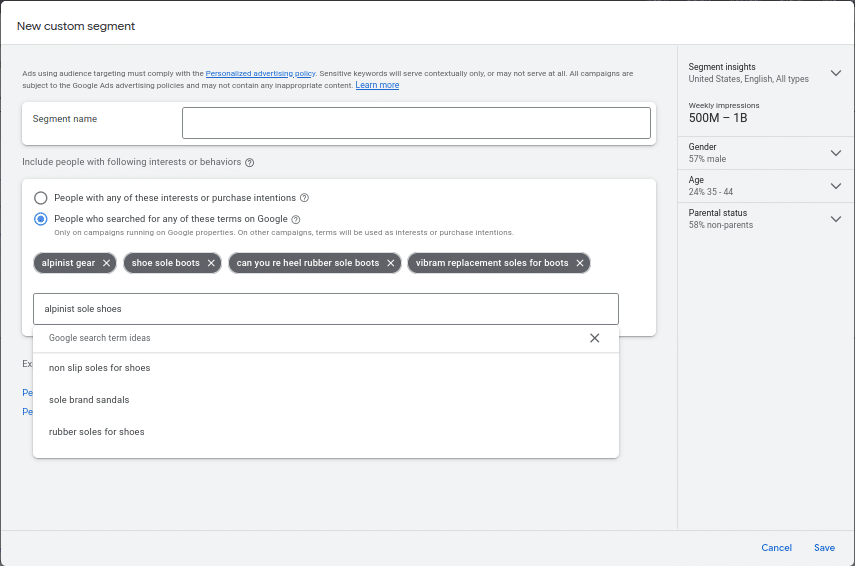
How to Select Websites and Apps for Custom Segments
There are many options to choose from when defining custom segment users by the websites they visit (or apps they use).
To create a segment with hot prospects, focus on the reason users spend time on these websites and apps when you create the list.
For example, if you sell marathon shoes, you can add websites about nutrition, sport medicine, navigation tech, marathon organizations, sports news, etc. All of these users are interested in the topic, but to convert them, you have to think about why they visit these sites and why they use these apps.
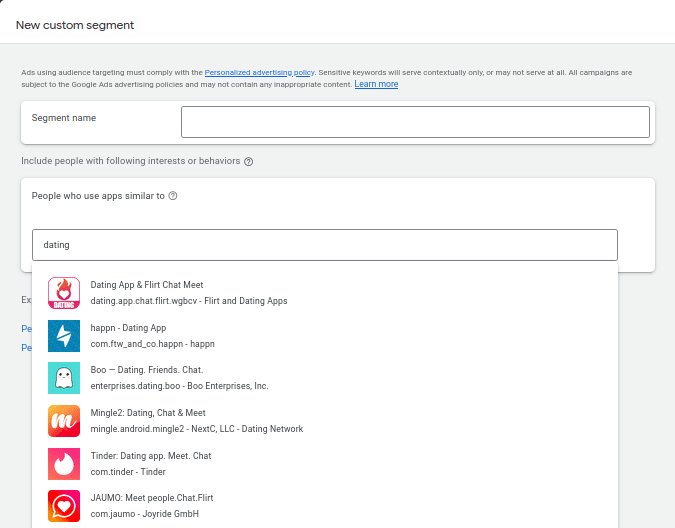
Don’t add entries just for the sake of it. Otherwise, you’ll end up targeting users who have nothing to do with your brand (i.e., follow sports news but have no intention to participate in a marathon, let alone buy shoes from you).
Let’s examine why this is so.
How NOT to Do Custom Segment Targeting
Some marketers who are new to custom segments (or simply want to improve their performance) focus on reaching as many users as possible.
To do this, they define the audience by dumping all of the keywords from their keywords list and then add all sorts of websites and apps.
And, yes, the estimated weekly impressions of such custom segments are in the billions.
Is this the best way to use custom segments in Google Ads?
Of course not.
Custom segments serve to discover the segments that are most valuable to your brand. Overcrowding the audience definition with keywords, URLs, and apps is against the very purpose of creating a custom segment.
How to Use Custom Segments
Let’s check three scenarios in which you should consider using a custom segment in a campaign:
- You want to target the customer base of your competitors
These are qualified, low-funnel prospects with high purchase intent, and custom segments are one of the best ways to tap into these users.
- You can’t afford keyword targeting in a search campaign
Keyword bids get very expensive very quickly, especially in competitive markets. Custom segments are likely to perform at a lower CPC relative to a traditional search campaign.
- You have a clear idea about the buyer persona you want to target
This one is valid only if you have an intimate understanding of the online behavior of your customers. If they visit X pages, search Y keywords, and use Z apps, you can easily get to them.
There are other reasons to create custom audience segments, but these are some of the most prominent ones.
Custom Segment Examples
The potential for custom segments is literally endless. I’ve created two custom segments to serve as an example, so you can see how audience definition works in Google Ads.
One is for “outdoor kitchen cabinets” and the other is for “water backpack for running” Check them out below.
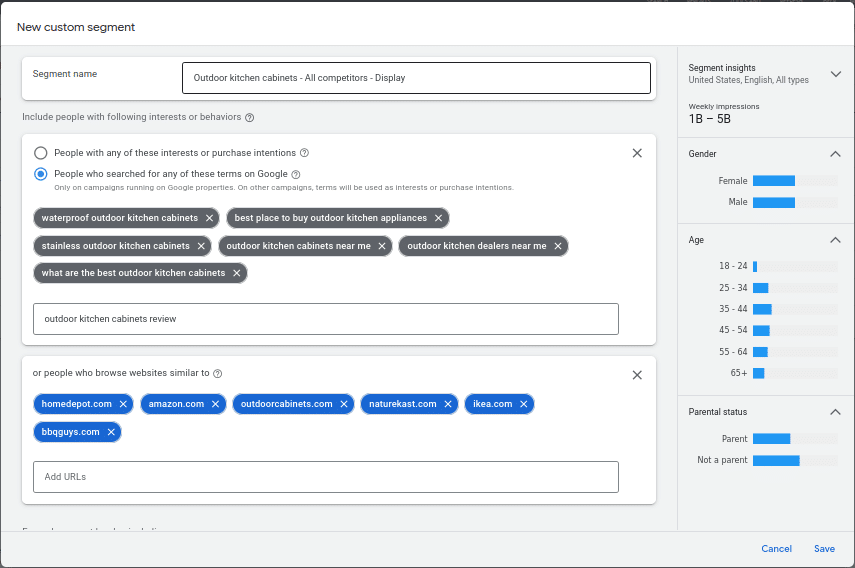
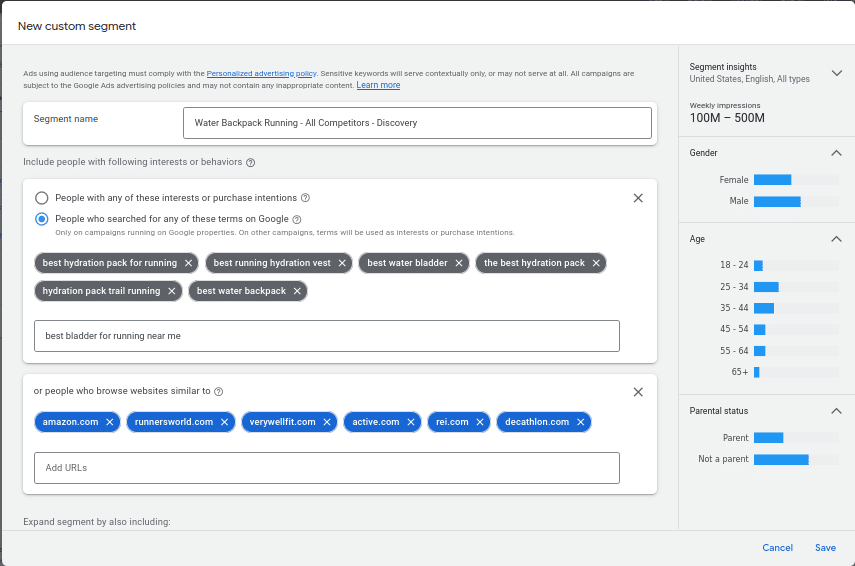
Custom Affinity & Custom Intent Audiences
For a long time, Custom Intent audiences and Custom Affinity audiences were popular with marketers. Now, they are no longer available because their functionalities are absorbed into custom segments.
Custom Intent audiences were defined by keywords and URLs, while Custom Affinity audiences were defined by keywords, URLs, and apps. The transition was smooth, and marketers could continue to use existing segments even after the name was changed to custom segments.
Testing Custom Segments
Let’s reiterate.
The purpose of custom segments is to find new customers from the gigantic pool of data on Google users. Constant testing is pivotal,no formula can give you a high-converting audience on a platter.
Your creativity will play a big role in this process, as is your ability to note and interpret feedback from the performance of custom segments. Usually, marketers develop elaborate audience segmentation when testing.
And to do this right, you might consider adopting some method.
Consistent Naming Convention for Tests
Once you create dozens of custom segments, it’s important to keep track of the criteria used to create them. This is best done by using a standardized naming convention.
It’s recommended to use more than one designation to specify a custom segment in the name. This helps to get an idea about the audience definition criteria by simply checking the name.
Elements often used in names include:
- campaign type,
- product,
- target buyer persona,
- target keywords,
- target competitors, etc.
These are all self-evident. Do you really need a complex naming convention?
Yes, you do.
Because if you want to create a separate custom segment for each of the competitors (and let’s say there are seven of them), then you need to come up with seven different names.
Testing Custom Segments in Ad Groups and Campaigns
To compare the performance of different custom segments, you need to develop elaborate audience segmentation within the same Ad Group (or Campaign). This is the best way to note the differences.
Here, you add multiple audiences, each defined by different criteria. For example:
- 2 high intent keywords, 1 competitor website, 3 apps;
- 1 high intent keyword, 1 competitor website, no apps;
- 1 high intent keyword, all competitor websites, no apps;
- 4 high intent keywords, all competitor websites, no apps;
- 1 high intent keyword, dominant competitor in the market (website), 1 app.
As you can see, the combinations are practically endless.
Following on the example custom segment on “outdoor kitchen cabinets” described above, you’d need a separate campaign or ad group for:
- “Best place to buy outdoor kitchen appliances” + Homedepot.com
- “Best place to buy outdoor kitchen appliances” + Amazon.com
- “Best place to buy outdoor kitchen appliances” + naturekast.com
- “Best place to buy outdoor kitchen appliances” + Homedepot.com, Amazon.com, naturekast.com + iScape, Houzz, etc.
You get the gist.
Testing Beyond Custom Segments
The audience is just one aspect of testing in digital marketing. If your goal is to maximize conversions, you can also try to test elements like ad creative, landing page, call to action, etc.
Even if you find out that users who search for X keyword, visit the website of competitors n.3, and use the app Y are the best-performing audience, a relevant landing page, catchy ad creative, or call to action that corresponds with the stage of the customer’s buying journey will further bump conversions.
Well, that’s a wrap!
Hopefully, by now, you have a better understanding of the power of custom segments (previously called custom audiences) in Google Ads.
Just remember, your ideal customer persona might not be a cookie-cutter mold, but with custom segments, you can still find and target them.
So go ahead, experiment with different combinations, and may the ad odds be ever in your favor!
If you still want to dig more, I can guide you through everything you need to know to create effective and profitable campaigns using custom segments and other powerful targeting options.
Enroll in my course now and let’s get started.
